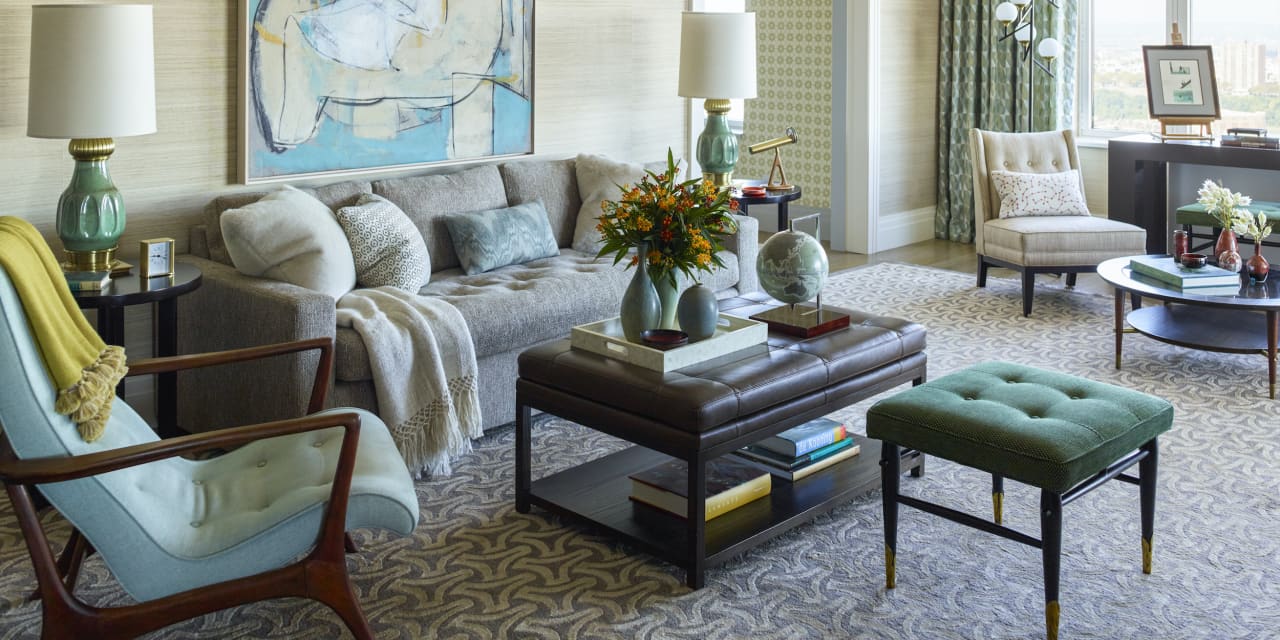If you’ve ever found yourself paging through shelter magazines for inspiration on blending different styles and furniture periods, then you’ll know that the pros prove that furnishings don’t need to match.
“Most rooms that primarily incorporate matchy-matchy furnishings lack wow factor,” said designer Lorna Gross in Bethesda, Maryland. “The most alluring rooms have a blend of styles.”
To help you create that eclectic designer look at home, Mansion Global asked four designers to weigh in on blending furniture from different styles and periods.
 For a curated space, select pieces you love, Dan Mazzarini said.
For a curated space, select pieces you love, Dan Mazzarini said.“I like to think of the home as a runway show. Pieces can differ, but you want everything to hang in the same closet. Choose pieces with a visual vocabulary that relate to and complement one another through silhouette, materiality or palette. Patinaed pieces carry an authentic warmth that cannot be replicated, and blending them with contemporary pieces feels updated and just how people live today.
“I love combining French deco, Scandinavian and modern. There’s something about the polished and worn patina of the 1920s that blends with the clean lines of Scandinavian pieces, cleaner, more modern metal, and leather ottomans and chairs.
“I’ve found the key is simply sourcing pieces you love. As a collector, I often find myself picking up antiques and thrifts that I’m drawn to even before I know where they will live. This approach will leave you with a curated space that feels incredibly special.”
—Dan Mazzarini, creative director and principal of BDHM Design in New York
Find a Common Thread
 According to designer Lorna Gross, all furniture pieces should relate to one another.
According to designer Lorna Gross, all furniture pieces should relate to one another.“My approach is to always allow a space to breathe. It’s hard to appreciate beautiful elements in overly cluttered spaces.
“Mixing a few more traditional pieces with modern furnishings can work quite well. They should, however, relate to each other in some way, especially if they’re in proximity. “Maybe each features a certain finish, color or metallic detail. Or maybe together, they serve a certain function, like a traditional chair paired with a contemporary ottoman.
“When mixing, every element selected should be given careful consideration, even the final touches.
“If a project requires a fresh or more modern aesthetic, I select and mix furnishings from periods that feature clean lines. For example, blending Art Deco or mid-century pieces with transitional and modern furnishings can create interesting spaces without overwhelming them.”
—Designer Lorna Gross in Bethesda, Maryland
Test out Different Styles
 Emily June Spanos likes to use one or two pieces from each period and style in a room.
Emily June Spanos likes to use one or two pieces from each period and style in a room.“I always try to mix more than one style and generally only use one to two pieces from each period and style. This ensures that the look doesn’t feel overly matchy-matchy or as if we were trying to match pieces and came up short. I also always try to incorporate a modern element alongside older antique pieces.
“Pay attention to scale, finish and overall style. You want to make sure each piece complements the other and also flows into the greater design style. Leaning too much into one period while only adding bits and pieces of the other can end up with a design that feels disjointed or ill-planned.
“Test out different styles together, and over time, you’ll figure out what you like. Traditional antiques work beautifully in a farmhouse or transitional setting and can even serve as the perfect complement to a more rustic interior. Decorating is merely an act of arranging furniture and decor and often rearranging it until it works.”
—Designer Emily June Spanos in Houston
Tie It All Together With Accessories
“We’ve been seeing vintage decor become more and more popular in the last year, and I expect the trend to continue in 2024. Because of this, people are incorporating vintage pieces into their modern or traditional homes for an eclectic aesthetic, utilizing furniture from different decades. Whether it’s a family heirloom or thrifted furniture, adding meaningful pieces to your space will make it feel personalized and curated.
“A great way to begin is by selecting one stand-out piece like a vintage armoire or mid-century armchair, then pairing it with more neutral furniture in the rest of the room. Accessories are an important part of tying an entire design together. A favorite family heirloom or collection of vintage plates can often inspire the entire design, tying in different furnishings.
“If there is a piece of decor that may not fit with the rest of your space, I recommend mixing it in without being the focal point of the room or layering it within other decor. There’s no harm in moving things around your home and seeing what feels right.”
—Designer Gideon Mendelson in New York

